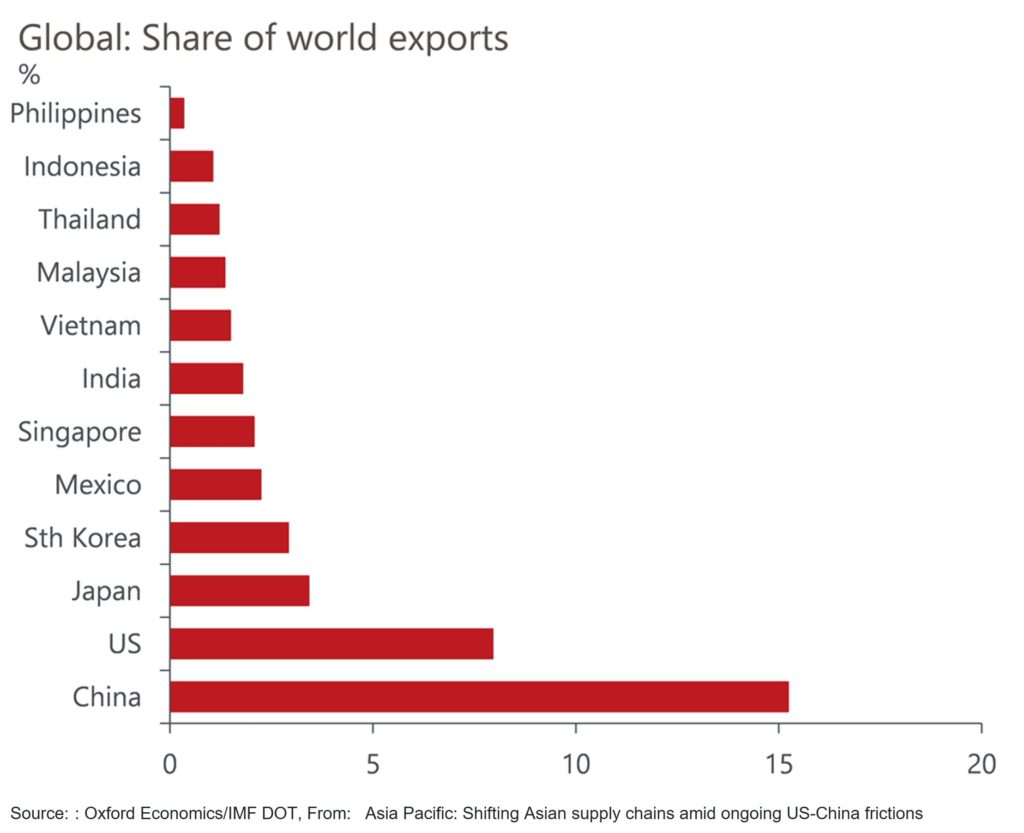The Great Decoupling: Reshaping Global Supply Chains

Table of Contents
Drivers of the Great Decoupling
The Great Decoupling is not a singular event but the culmination of several interconnected factors. Understanding these drivers is crucial for businesses seeking to adapt and thrive.
Geopolitical Risks and Instability
Rising geopolitical tensions have significantly disrupted global supply chains. The escalating US-China trade war, punctuated by tariffs and sanctions, forced businesses to reconsider their over-reliance on single sourcing from China. Similarly, the Russia-Ukraine conflict drastically impacted energy supplies and the availability of crucial raw materials, highlighting the fragility of globally integrated supply chains. These events underscore the growing importance of:
- Diversifying sourcing: Reducing dependence on any single supplier or geographical region.
- Risk mitigation strategies: Implementing contingency plans to address potential disruptions.
- Geopolitical forecasting: Incorporating geopolitical risk assessment into supply chain planning.
- Supply chain mapping: Gaining a clear understanding of the entire supply chain network to identify potential vulnerabilities.
Pandemic-Induced Disruptions
The COVID-19 pandemic exposed the vulnerabilities of just-in-time (JIT) manufacturing models, which prioritize efficiency by minimizing inventory. Lockdowns, port congestion, and transportation disruptions crippled global supply chains, leading to significant shortages and delays. The pandemic highlighted the need for:
- Increased inventory levels: Holding more safety stock to buffer against unforeseen disruptions.
- Supply chain diversification: Reducing reliance on single sourcing and geographical concentration.
- Enhanced supply chain visibility: Implementing technology to track goods and anticipate potential bottlenecks.
- Robust contingency planning: Developing comprehensive plans to address various disruption scenarios.
The Rise of Protectionism and Regionalization
Governments worldwide are increasingly prioritizing domestic production and regional trade agreements. This shift towards protectionism is driving a wave of nearshoring and reshoring initiatives, where companies move manufacturing and operations closer to their home markets. This trend is reshaping global supply chains by:
- Reducing global integration: Creating more regionalized and fragmented supply chains.
- Increasing transportation costs: As goods travel shorter distances, transportation costs may rise initially.
- Creating new trade dynamics: Regional trade agreements are leading to new partnerships and competitive landscapes.
- Promoting domestic jobs: Reshoring efforts aim to create jobs within national borders.
Consequences of the Great Decoupling
The Great Decoupling has far-reaching consequences, impacting businesses, consumers, and the global economy as a whole.
Increased Costs and Inflation
Supply chain disruptions have significantly contributed to rising inflation. Increased transportation costs, raw material scarcity, and labor shortages have driven up the prices of goods and services, impacting consumer purchasing power. This necessitates:
- Cost optimization strategies: Implementing efficient processes to reduce expenses.
- Price adjustments: Carefully evaluating price increases to maintain market competitiveness.
- Negotiating with suppliers: Maintaining strong relationships to secure favorable pricing and terms.
Restructuring of Global Supply Chains
The Great Decoupling is forcing a fundamental restructuring of global supply chains. Companies are actively diversifying their sourcing, exploring nearshoring and reshoring options, and investing in supply chain visibility technologies. This involves:
- Supply chain mapping: Creating a comprehensive overview of all supply chain links.
- Risk assessment: Regularly evaluating supply chain vulnerabilities.
- Supplier diversification: Building relationships with multiple suppliers in different geographical regions.
- Nearshoring/Reshoring: Exploring options to bring production closer to home markets.
Impact on Businesses and Consumers
Businesses face significant challenges in adapting to the changing landscape, requiring investment in new technologies, supply chain management systems, and strategies for mitigating risk. Consumers are experiencing higher prices and potentially reduced product availability. This calls for:
- Business resilience strategies: Building adaptable and robust business models.
- Enhanced supply chain management: Implementing best practices to improve efficiency and reduce risk.
- Consumer education: Communicating transparently with consumers about price increases and potential delays.
Strategies for Navigating the Great Decoupling
Successfully navigating the Great Decoupling requires proactive strategies that focus on resilience, technology, and collaboration.
Building Supply Chain Resilience
Building a resilient supply chain is no longer optional; it's a necessity. Key strategies include:
- Diversification: Spreading sourcing across multiple suppliers and geographical locations.
- Redundancy: Building in backup plans and alternative suppliers to mitigate disruptions.
- Agility: Creating flexible supply chains capable of adapting to changing circumstances.
- Risk Management: Implementing robust risk assessment and mitigation strategies.
Embracing Technology and Automation
Technology plays a critical role in optimizing supply chain operations and enhancing resilience. This includes:
- AI-powered forecasting: Leveraging AI to predict potential disruptions and optimize inventory levels.
- Blockchain technology: Enhancing transparency and traceability throughout the supply chain.
- Automation: Automating processes to improve efficiency and reduce errors.
- Digital supply chain platforms: Utilizing cloud-based platforms to improve collaboration and data sharing.
Fostering Collaboration and Partnerships
Strong relationships with suppliers, logistics providers, and other stakeholders are crucial for navigating the complexities of the Great Decoupling. This includes:
- Open communication: Maintaining open lines of communication with all stakeholders.
- Collaborative planning: Working together to anticipate and address potential disruptions.
- Information sharing: Sharing data and insights to improve decision-making.
Conclusion: Understanding and Adapting to the Great Decoupling
The Great Decoupling represents a profound shift in the global economic landscape. Understanding its drivers and consequences is crucial for businesses seeking to build resilient and adaptable supply chains. The key to navigating this new reality lies in embracing diversification, leveraging technology, and fostering strong collaborative partnerships. To navigate the complexities of the Great Decoupling and build a more resilient future, explore advanced supply chain management techniques and strategies. Learn more about [link to relevant resource]. The future of global supply chains depends on our ability to adapt to this new era of the Great Decoupling and its evolving impact on global trade and geopolitical risk.

Featured Posts
-
 Dwp Reforms Impact On Universal Credit Recipients
May 08, 2025
Dwp Reforms Impact On Universal Credit Recipients
May 08, 2025 -
 Superman In The Dcu Speculation Mounts Over Release Timing
May 08, 2025
Superman In The Dcu Speculation Mounts Over Release Timing
May 08, 2025 -
 Liga Chempionov 2024 2025 Predvaritelniy Obzor Polufinalov Arsenal Ps Zh Barselona Inter
May 08, 2025
Liga Chempionov 2024 2025 Predvaritelniy Obzor Polufinalov Arsenal Ps Zh Barselona Inter
May 08, 2025 -
 Us China Trade Deal Spurs Bitcoin Price Increase
May 08, 2025
Us China Trade Deal Spurs Bitcoin Price Increase
May 08, 2025 -
 How To Watch Oklahoma City Thunder Vs Houston Rockets Game Preview And Betting Tips
May 08, 2025
How To Watch Oklahoma City Thunder Vs Houston Rockets Game Preview And Betting Tips
May 08, 2025
Latest Posts
-
 Merkt Marakana Tfasyl Isabt Barbwza Bfqdan Alasnan
May 08, 2025
Merkt Marakana Tfasyl Isabt Barbwza Bfqdan Alasnan
May 08, 2025 -
 Jayson Tatum And Ella Mai Commercial Hints At New Baby
May 08, 2025
Jayson Tatum And Ella Mai Commercial Hints At New Baby
May 08, 2025 -
 Ma Hdth Lbarbwza Fy Marakana Fqdan Alasnan Fy Merkt Qwyt
May 08, 2025
Ma Hdth Lbarbwza Fy Marakana Fqdan Alasnan Fy Merkt Qwyt
May 08, 2025 -
 Isabt Barbwza Fy Marakana Tfasyl Fqdan Alasnan
May 08, 2025
Isabt Barbwza Fy Marakana Tfasyl Fqdan Alasnan
May 08, 2025 -
 Ntayj Merkt Marakana Khsart Barbwza Wfqdan Alasnan
May 08, 2025
Ntayj Merkt Marakana Khsart Barbwza Wfqdan Alasnan
May 08, 2025
